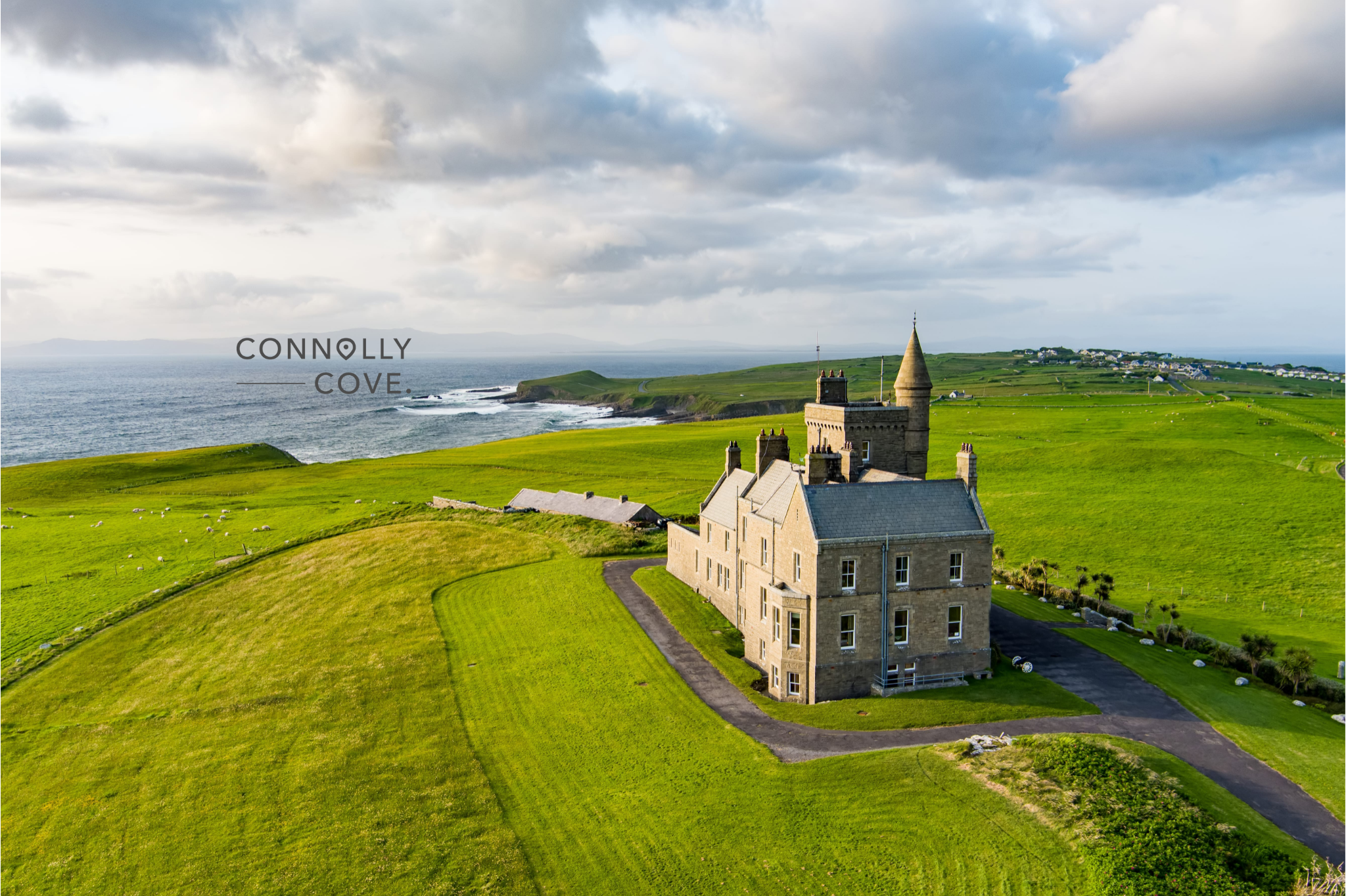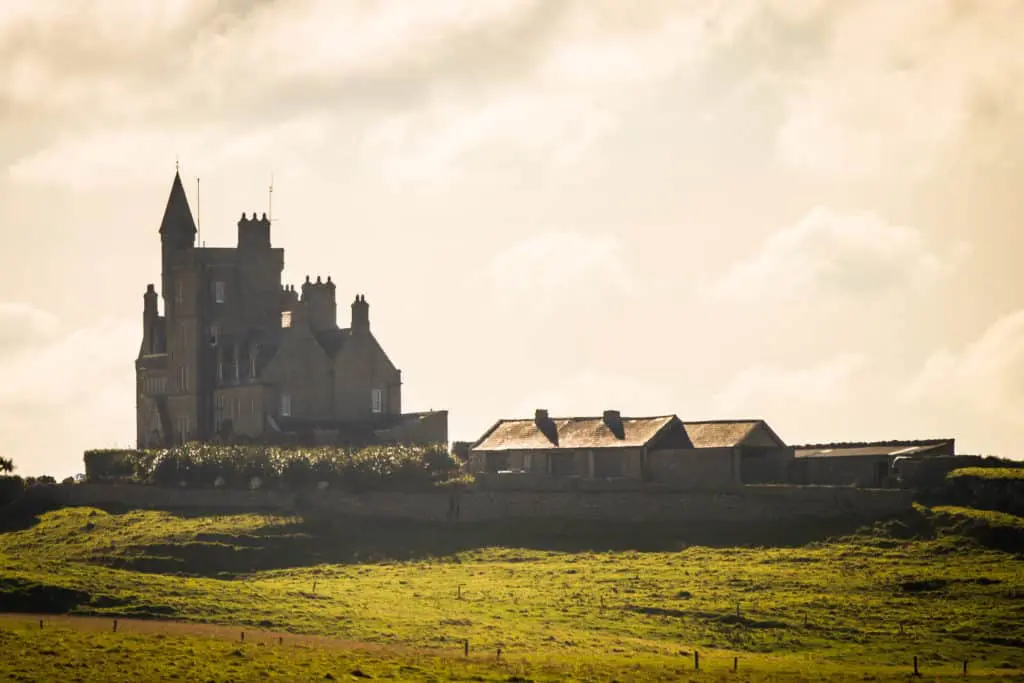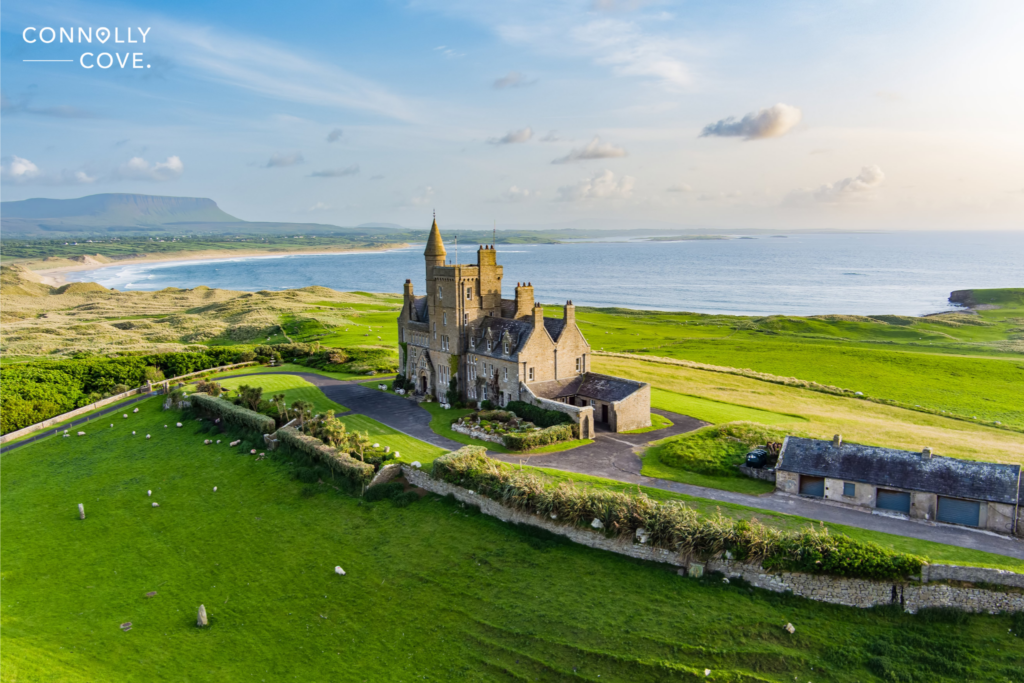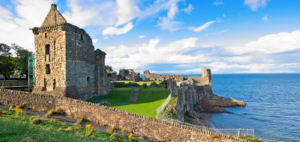Classiebawn Castle: Owned by Royals and Inhabited by Ghosts

Updated On: April 07, 2024 by Dina Essawy
Many legendary Irish castles have resident ghosts, and most ghost stories result from the tragic death of the person whose ghost now haunts said castle. The same applies to Classiebawn Castle, located near the village of Cliffoney, County Sligo, in the Republic of Ireland.
Classiebawn Castle stands as a symbol of aristocratic grandeur and storied history. Built in the early 19th century by the renowned architect John Nash, this magnificent estate overlooks the wild Atlantic Ocean from its perch atop the windswept cliffs of Mullaghmore Peninsula. From its imposing facade to its sweeping vistas, Classiebawn Castle has long been revered as a cherished retreat for the aristocracy, offering respite from the tumult of the outside world.
The castle’s rich history is intertwined with tales of royal ownership and political intrigue, cementing its place as a legendary landmark. Initially commissioned by Sir Henry Gore-Booth, the castle later passed into the hands of the Mountbatten family, adding a royal pedigree to its illustrious legacy. Lord Louis Mountbatten, a decorated naval officer and cousin of Queen Elizabeth II, made the castle his summer residence, hosting esteemed guests, including members of the British royal family. Yet, alongside its royal associations, Classiebawn Castle is also shrouded in ghostly legends, with reports of spectral apparitions haunting its halls and cliffs.
Table of Contents
A Little History of Classiebawn Castle
Classiebawn Castle is a country house built for The 3rd Viscount Palmerston (1784–1865) on the Mullaghmore Peninsula in County Sligo. However, most original buildings were expanded in the late 19th century.
The land on which Classiebawn Castle was built originally belonged to the O’Connor Sligo family. Still, the English Parliament confiscated it to compensate the people who successfully put down an Irish rebellion. The land was granted to Sir John Temple (1600-1677), Master of the Rolls in Ireland.
Later on, the property was passed down to the 3rd Viscount Palmerston, who served as both British Prime Minister and British Foreign Secretary during the reign of Queen Victoria. Sadly, the house was incomplete before he died in 1865, but in 1874 by his stepson and successor, The Rt. Hon. William Cowper-Temple, P.C., M.P. (later created The 1st Baron Mount Temple). Following the latter’s death, and since he was childless, the estate passed to his nephew, The Hon. Evelyn Ashley, the second surviving son of The 7th Earl of Shaftesbury. In 1907, the estate passed to his only son, Wilfrid Ashley (later created Baron Mount Temple in a new creation).
Design and Architecture of Classiebawn Castle

Classiebawn Castle was designed in the Baronial style by Dublin-based architect J. Rawson Carrol. Interestingly, the castle is constructed from yellow-brown sandstone brought by sea from County Donegal. It comprises a gabled range with a central tower topped by a conical-roofed turret.
Until 1948, the castle was lit using oil lamps and candles. Transporting fresh water to the castle was also arduous because a donkey had to cart it a quarter of a mile uphill from a spring well.
Another method was collecting rainwater on the Castle roof, which fed a large underground tank. However, it had to be pumped by a heavy-hand wheel. There was only one old-fashioned bath in the entire castle.
Part of Irish History
Classiebawn Castle was used as a barracks for the Free State Army during the Irish Rebellion. The army flew its flag there and protected the castle from damage. In 1916, Lord Mount Temple emptied the castle of all furniture and remained as such until 1950. When the Irish Rebellion ended, the castle was handed back intact to Lord Mount Temple, who had been a popular landlord.
The Mountbattens and Connections to the Current Royal Family
In 1939, Classiebawn Castle was inherited by The Rt. Hon. Edwina, Countess Mountbatten of Burma, and her husband, Admiral of the Fleet, The 1st Earl Mountbatten of Burma, who made several improvements to the castle, including installing electricity and a central water supply. After the Countess’ death in February 1960, Lord Mountbatten, who was the last Viceroy of India, spent his summers at Classiebawn Castle until his tragic death when the IRA blew up his boat near the coast of Mullaghmore in August 1979.
Interestingly, the 1st Earl of Mountbatten is an uncle of Prince Philip, Duke of Edinburgh, husband of Queen Elizabeth II. He is also Queen Elizabeth II’s second cousin once removed.
The castle and surrounding lands are now owned by the estate of Hugh Tunney (1928-2011), who bought the castle in 1991.
Ghost Stories and Paranormal Activity

It was Lord Mountbatten’s tragic death that spawned the haunting stories surrounding the castle, as his ship was blown up by the IRA in 1979. Legend has it that his ghost is still roaming the halls of the castle, unable to find peace as a result of his violent and sudden death.
It is also interesting to note that Lord Mountbatten was practically royalty. The deceased nobleman was Queen Victoria’s grandson, the Prince of Wales’s great uncle, the last Viceroy of India, and the former Supreme Allied Commander during WWII. Queen Elizabeth alluded to the tragic incident during a royal visit to Ireland in 2011, saying that the Troubles had “touched” the Royal family personally.
Four people had died in that tragic explosion that took the life of the Lord of the manor: Mountbatten, his grandson Nicholas, Lady Brabourne and Paul Maxwell.
The explosion was so massive that fragments and shattered wood flew everywhere and were picked up by fishermen for days afterwards. Gardai made an effort to collect these pieces and put them back together to try and discover exactly what had happened: the location of the bomb in the boat, how it was detonated, and what kind of explosives were used. Fortunately, the fishermen who collected pieces of the boat while out on lobster fishing trips handed the fragments they found over. A helicopter hovered over the site for weeks, and divers scoured the seabed to look for clues.
The explosion was widely reported worldwide, and reporters from the international press and T.V. poured into the village. On the day of the tragic event (29 August 1979), Hugh Tunney, the current owner of Classiebawn, claims that young Knatchbull asked his mother, Lady Pamela Mountbatten, ‘Why did they do this to Grandpapa?’ Her reply was: ‘Oh, they have their reasons, son. They have their reasons.’
‘I have a place in Eire, Classiebawn Castle in County Sligo,’ Mountbatten told a gathering of the Empire Club of Canada in 1967, ‘and I and my family could not be treated with greater friendship by the Irish. My son-in-law’s grandmother was the Marchioness of Sligo, who died not long ago at the age of 98. Shortly before the second election for which Mr De Valera stood, Lady Sligo asked her head gardener: “Do you think Mr De Valera will be re-elected?” He replied: “Of course he will, your Ladyship. After all,, people experiencing poverty got him elected last time, and there are many more poor now.’
To this day, it is believed that the bomb was triggered by a remote control device from the cliffs overlooking the bay. Thomas McMahon of Monaghan and Francie McGirl of Leitrim were tried for the murder and convicted in a non-jury court.
A reporter for the Belfast Telegraph visited the area and interviewed some of the locals ahead of a visit by Prince Charles to Classiebawn Castle back in 2015. Prince Charles would be the grand-nephew of the slain Lord Mountbatten.
The reporter spoke to an elderly man from the area who recalled the tragic events, “I remember it as though it were yesterday. The ambulances, the medical people, all the journalists. It seemed wrong that something so terrible could happen in a place as special as Mullaghmore. But it’s not something that people talk about any more. I think we’ve done our talking and are just a bit fed up that, for some, it’s all that’s ever mentioned when they talk of Mullaghmore.”
A local historian, Joe McGowan, said, “Look out on the tranquil waters of the bay, and it’s impossible to imagine that something so horrible could happen here. There was huge media interest then, but that faded away, and everything returned to normal.”
Modern Day
Today, Mullaghmore is a holiday village mainly occupied by holiday homes for the wealthy. Their yachts throng the harbour, which was built by Lord Palmerston in 1820. In the summer, holidaymakers crowd the village.
Despite its tragic past, Classiebawn continues to thrive as a tourist destination. Its sunny weather and sprawling gardens are perfect for photo ops, and the nearby hotels always welcome tourists from across the globe.
Preservation and Legacy
Despite its turbulent past and the passage of time, Classiebawn Castle stands as a testament to its enduring beauty and historical significance. Following Lord Mountbatten’s tragic assassination by the IRA in 1979, the castle remained in the possession of the Mountbatten family before being sold to private owners in the 1990s. Today, Classiebawn Castle remains cherished as a private residence, and its rich heritage is preserved for future generations to appreciate.
In recent years, efforts have been made to maintain and protect the castle’s architectural integrity and historical significance. Restoration projects have ensured that Classiebawn Castle retains its majestic allure while safeguarding its legacy for posterity. From its imposing turrets to its ivy-clad walls, the castle is a tangible link to Ireland’s past and a testament to the enduring allure of aristocratic splendour.
Conclusion
Classiebawn Castle remains a symbol of aristocratic grandeur and historical intrigue, its storied past intertwined with tales of royal visits and ghostly apparitions. Perched on the windswept cliffs of Mullaghmore Peninsula, this magnificent estate continues to captivate the imagination of visitors and locals alike. Whether admired for its architectural splendour, royal connections, or ghostly legends, Classiebawn Castle is a timeless icon of Ireland’s rich heritage and enduring mystique.







Is the ground, s of the castle open to the public
Hi Jackie
As far as we are aware, the castle is on private grounds so unfortunately not open to the public.